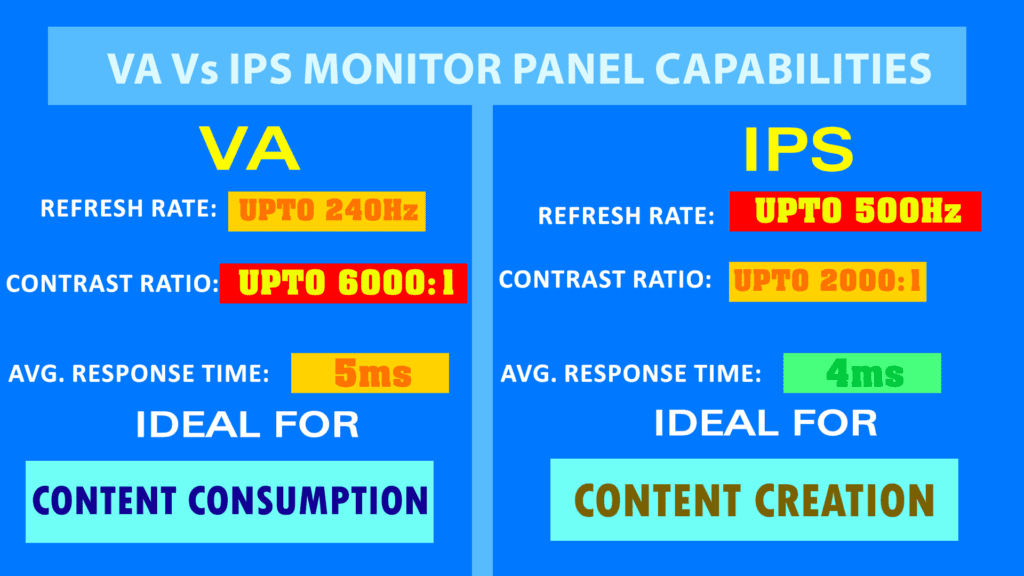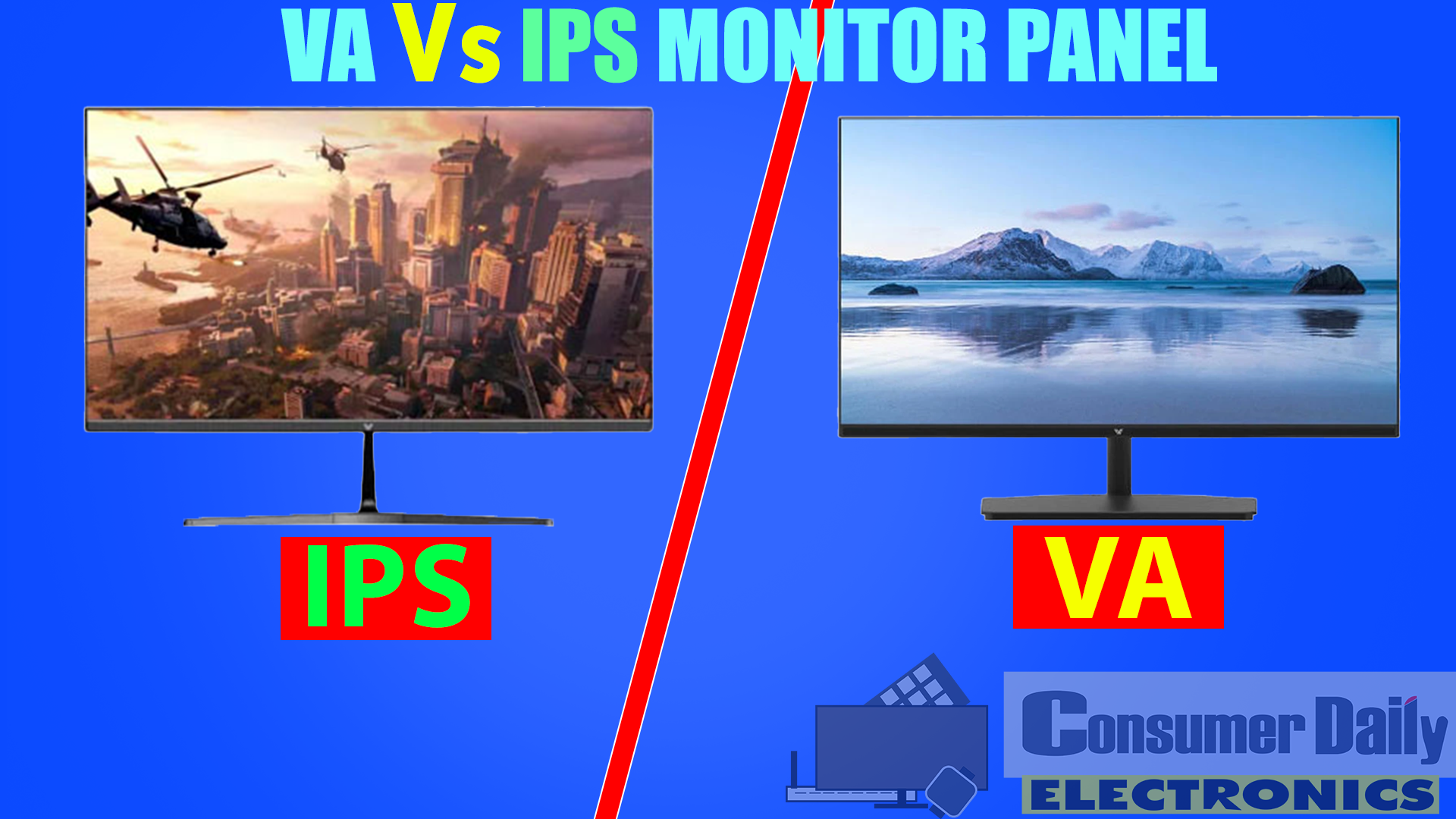Introduction
When choosing a monitor, the type of panel plays a great role in determining your experience. Two of the most popular options are VA (Vertical Alignment) and IPS (In-Plane Switching) panels. Each type has its own strengths and weaknesses, making them suitable for different uses. Whether you’re gaming, working, or just watching movies, understanding the difference between these panels will help you make an informed decision.
Let’s dive deep into discussing VA Vs IPS monitor panels to see which one aligns best with your needs.
Understanding the Monitor Panel Types
Understanding VA (Vertical Alignment) Panels
VA panels use a unique liquid crystal alignment that tilts vertically when voltage is applied. This enables them to achieve deeper blacks and greater contrast ratios compared to other monitor panel technologies. A typical VA panel offers excellent contrast, often reaching a ratio of 3000:1 or higher.
Strengths of VA Panels:
- Superior contrast ratios, up to 6000:1
- Deeper black levels, ideal for dark scenes
- Affordable compared to high-end IPS monitors
Weaknesses of VA Panels:
- Slower response times can lead to motion blur
- Narrower viewing angles compared to IPS
Understanding IPS (In-Plane Switching) Panels
IPS panels, on the other hand, use liquid crystals that align horizontally. This technology improves color reproduction and viewing angles, making it a popular choice for professionals.
Strengths of IPS Panels:
- Wide viewing angles with minimal distortion
- Excellent color accuracy, suitable for designers and editors
- Faster response times, ideal for gaming
Weaknesses of IPS Panels:
- Lower contrast ratios compared to VA, generally around 1000:1
- Deep blacks may be slightly greyed out
- Generally more expensive
Comparing VA Vs IPS Monitor Panels
Image Quality and Color Accuracy
IPS panels are the go-to choice for users seeking vibrant, accurate colors. These panels shine in professional settings like photo editing and graphic design. VA panels, however, deliver exceptional contrast, making them great for movies and immersive story-focused gaming.
Viewing Angles
IPS panels clearly dominate in this category. They offer consistent colors and clarity even at extreme angles. VA panels, while better than TN panels, still exhibit color shifting at wider angles.
IPS panels can deliver consistent colours even at around 178° angle. But in case of VA monitors, the colour is generally changed or desaturated out.
Response Times and Refresh Rates
Response time determines how fast a pixel shifts from one color to another. IPS panels usually have faster response times, reducing motion blur, which is crucial for competitive gaming. Modern VA panels have improved significantly, but they still lag slightly behind IPS in this regard.
In case of refresh rate, IPS panels are the best. IPS panel monitors can deliver a maximum of around 500Hz refresh rates, where VA panels only stick around 240Hz. Even if higher refresh rate VA panel monitors are developed, they’ll still struggle in case of response times.
Contrast and Black Levels
VA panel monitors are unbeatable when it comes to contrast and black levels. Their high contrast ratios bring out details in dark scenes, making them perfect for movies and gaming in dimly lit environments. IPS panels often struggle with grayish blacks in similar conditions.
VA panels can show blacks in uniform way. They can actually show something which is considered black. However, in case of IPS panel monitors the blacks are slightly deep grey colour.
Use Cases and Recommendations

Best Scenarios for VA Panels
VA panels excel in cases where contrast and deep black levels are necessary. They are great for:
- Watching movies, especially in dark rooms
- Immersive gaming experiences with rich visuals
- Budget-friendly options for casual users
Best Scenarios for IPS Panels
If you emphasize on color accuracy and wide viewing angles, IPS panel monitors are your best options. Ideal for:
- Graphic designers and video editors
- Competitive gamers who need faster response times
- Office and professional use
Price Comparison and Market Availability
On average, VA panels are more affordable, making them an excellent choice for budget-conscious buyers. IPS panels tend to be pricier due to their advanced technology, wide viewing angles, superior colour reproduction and image quality. They are made with higher quality materials than VA panels. That said, the gap has narrowed in recent years as manufacturers push innovations.
However still IPS panels are more expensive
Key Considerations When Buying a Monitor
Before purchasing a monitor, ask yourself:
- What will I use it for? Gamers may lean toward IPS, while movie buffs might prefer VA.
- What’s my budget? IPS panels often come with an expensive price tag.
- What features matter most? Refresh rates, resolution, and connectivity options can also influence your decision.
Best Monitor Suggestions
Best IPS Panel Monitors
There are a lot of quality IPS panel monitors in the market. For typical home use you can check the HP M22F 21.5 Inch Monitor. It offers excellent value for its price. With 75Hz refresh rate, it also supports AMD FreeSync, making it good for story-based gaming.
For hardcore, competitive gaming, you may check out the LG UltraGear 24GN60R 24 Inch Gaming Monitor. It offers 144Hz refresh rate, together with 1ms response time(GTG) and AMD FreeSync, ideal for first-person shooters or racing games.
Best VA Panel Monitors
VA panel monitors are much cheaper than IPS panel ones. For normal content consumption like watching movies, TV shows etc, you can try the Lenovo L22e-40 21.45 Inch Monitor. With a VA panel, the monitor supports 75Hz refresh rate, 4ms response time and AMD FreeSync, also making it good for light gaming.
Although VA monitors are not recommended for competitive gaming, there are a lot of branded gaming monitors which use VA panels. Such as the Samsung Odyssey G3, which offers 165Hz refresh rate together with AMD FreeSync Premium and 1ms(MPRT) response time.
Advantages and Disadvantages of Each Panel
Pros of VA Panels:
- High contrast ratios
- Affordable price points
- Ideal for movies and immersive gaming
Cons of VA Panels:
- Narrower viewing angles
- Slower response times
Pros of IPS Panels:
- Accurate colors and wider viewing angles
- Faster response times for competitive gaming
- Better for creative and professional work
Cons of IPS Panels:
- Lower contrast compared to VA
- Generally more expensive
VA Vs IPS for Gaming: What’s Better?
For casual gamers, VA panels offer a visually rich experience, especially in story-driven games. However, competitive gamers often prefer IPS panels due to their faster response times and reduced motion blur.
VA Vs IPS for Work and Productivity
Professionals in creative fields like graphic design, photography, and video editing should opt for IPS panel monitors due to their superior color accuracy. VA panels, while good for general office work, may not deliver the precision required for creative tasks.
Video Comparison
Here’s a video comparison between VA and IPS monitors:
The Future of Monitor Panel Technologies
Both VA and IPS panels are evolving. Manufacturers are working to reduce the limitations of each technology. For instance, advanced VA panels now offer better response times, and new IPS displays are improving in contrast ratios. Exciting innovations like OLED and mini-LED panels are also entering the market.
Conclusion
Both VA and IPS panels have unique strengths, and the best choice depends on your specific needs. VA panels excel in contrast and immersive experiences, while IPS panels are the top choice for color accuracy and viewing angles. Assess your priorities and budget to make the right decision.
FAQs
1. What is better for movies: VA or IPS?
VA panels are better for movies due to their deep blacks and high contrast ratios.
2. Are IPS panels better for gaming?
For competitive gaming, IPS panel monitors are preferred due to their faster response times.
3. Do VA panels have ghosting issues?
Older VA panels may have ghosting, but modern ones have significantly improved in this area.
4. How do VA and IPS panels differ in terms of durability?
Both types are durable, with no significant differences in lifespan.
5. Can both VA and IPS panels support 4K resolution?
Yes, both VA and IPS panels can support 4K resolution, depending on the monitor model.
Related: HP M22F Monitor Review: An Amazing Budget 21.5 Inch FHD Monitor

